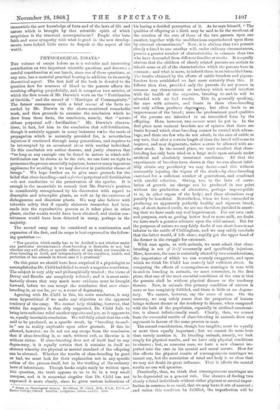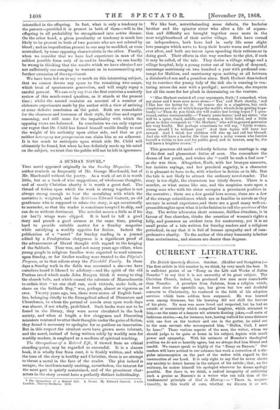PHYSIOLOGICAL ESSAYS.*
Essays ea Physiological SuVecls. By Gilbert W. Child, 3LD., F.L.S. F.C.S., of Exeter Caw, oxford. London: Longmans, Green, and Co. 1SGS. and unless this condition be fulfilled, the imperfection will be
TnE volume of essays before us is a valuable and interesting contribution on two important scientific questions, and deserves a careful consideration at our hands, since one of these questions, at any rate, has a material practical bearing in addition to its merely theoretical aspect. The first half of the book is devoted to the question how far nearness of blood in the parents affects the resulting offspring prejudicially, and it comprises two articles, of which the first treats of Mr. Darwin's work on the " Fertilization of Orchids, " and the second of " Marriages of Consanguinity."
The former commences with a brief resume of the facts re- corded by Mr. Darwin in the above-mentioned remarkable
work, and then proceeds to examine the conclusion which he drew from these facts, the conclusion, namely, that " nature abhors perpetual self - fertilization." Mr. Darwin's observa- tions, in fact, led him to the conclusion that self-fertilization, though it certainly appears in many instances toe be the mode of propagation which is naturally provided for, is nevertheless injurious if continued through many generations, and requires to be interrupted by an occasional cross with another individual.
To this conclusion our author demurs, and justly observes that "'as long as any example can be found in nature in which self- fertilization can be shown to be the rule, we can have no right to
pronounce theprocess essentially injurious, however many ingenious appliances for avoiding it we may discover in particular classes of beings." We hope further on to give some grounds for the belief that close-breeding—and a fortiori perpetual self-fertilization
—is not conductive to the preservation of the species. It is enough in the meanwhile to remark that Mr. Darwin's position is considerably strengthened by his discoveries with regard to dimorphic and trimorphic plants, as well as by the existence of dichogamous and dioecious plants. We may also believe with tolerable safety that if equally elaborate researches had been made into the reproductive process as it takes place in other plants, similar results would have been obtained, and similar con- trivances would have been detected in many, perhaps in the majority.
The second essay may be considered as a continuation and expansion of the first, and its scope is best expressed in the follow- ing quotation :—
" The question which really has to be decided is not whether under any particular circumstances close-breeding is desirable or not but whether any evil effect, or specific effects of any kind, are traceable to close-breeding in itself, and independently of the condition, health, and perfection of the animals in whose ease it is practised."
On this point we should have been surprised if a physiologist as accomplished as Dr. Child had failed to reach a negative conclusion. The subject is very ably and philosophically treated ; the views of Devay and Boudin are completely refuted ; and it is most satis- factorily shown that very much more evidence must be brought forward, before we can accept the conclusion that mere close- breeding is, or can be, per se, a cause of degeneracy.
Agreeing with Dr. Child in this, his main conclusion, it may seem hypercritical if we make any objection to the apparent tendency of the essay. We cannot help thinking, however, that whilst the negative is thus ably supported, Dr. Child fails to bring into sufficient relief another opposite and yet, as it appears to us, equally inevitable conclusion. We will fully admit that the evils said to be produced, as a specific result, by " breeding in-and- in" are in reality explicable upon other grounds. If this be allowed, however, we do not see any escape from the conclusion that if close-breeding is, as such, without evil, so likewise is it without virtue. If close-breeding does not of itself lead to any degeneracy, it is equally certain that it contains in itself no element whereby the physical or mental standard of the offspring can be elevated. Whether the results of close-breeding be good or bad, we must look for their explanation not in any specific action of the process itself, but in the working of the ordinary laws of inheritance. Though books might easily be written upon this question, the truth appears to us to lie in a very small compass, and it is somewhat singular that Dr. Child has not expressed it more clearly, since he gives various indications of
his having a decided perception of it. As he says himself, " The qualities of offspring at a birth may be said to be the resultant of the reaction of the sum of those of the two parents upon one another, together with the modifications superinduced upon them by external circumstances." Now, it is obvious that two parents closely related to one another will, under ordinary circumstances, possess a greater number of characteristics in common than two who have descended from different families or stocks. It is equally obvious that the children of closely related parents are certain to inherit some or all of the characteristics which the parents have in common ; and what is more, to inherit them in an intensified form. The results obtained by the efforts of cattle-breeders and pigeon- fanciers have established no fact more certainly than this. It follows then that, provided only the parents do not possess in common any characteristic or tendency which would interfere with the health of the organism, breeding in-and-in will be attended with no bad results. This is, generally speaking, the case with animals, and hence in them close-breeding not only seldom produces degeneiacy, but often leads to an improvement of the breed ; since the predominant good qualities of the parents are inherited in an intensified form by the offspring. Here, however, two caveats must be put in. In the first place most eminent breeders are of opinion that there are limits beyond which close-breeding cannot be carried with advan- tage, and there are few who do not admit, in the case of cattle at any rate, that after a certain length of time the breed will cease to improve, and may degenerate, unless a cross be allowed with an- other stock. In the second place, we must recollect that close- breeding has only been tried on a large scale upon animals under artificial and absolutely unnatural conditions. All that the experiments of breeders have shown is that we can almost infal- libly obtain any peculiarity we may desire—and this without
necessarily injuring the vigour of the stock—by close-breeding exercised for a sufficient number of generations, and combined with careful selection. Owing, too, to the laws of corre- lation of growth no change can be produced in one point without the production of alterations, perhaps imperceptible to us, in other organs of the body ; and these alterations may possibly be beneficial. Nevertheless, when we have succeeded in producing an apparently perfectly healthy and vigorous breed, say, of short-horned cattle, we are not therefore justified in assert- ing that we have made any real improvement. For our own ends and purposes, such as getting better beef or more milk, no doubt we have made a genuine advance upon the wild animal. But for the purposes of nature we may fairly doubt if our short-horn is not inferior to the cattle of Chillingham, and we may safely conclude that the latter would, if left alone, rapidly get the upper hand of the former in the struggle for existence.
With man again, as with animals, we must admit that close- breeding is not of itself necessarily and specifically injurious. Here, however, the case is materially altered by two considerations, the importance of which we can scarcely exaggerate, and upon which we think Dr. Child has scarcely laid sufficient stress. In comparing the effects of consanguineous marriages in man with in-and-in breeding in animals, we must remember, in the first place, that one of the most essential conditions of the case is that the parents shall be without physical disease or the tendency thereto. Now, in animals this primary condition of success is more or less completely fulfilled, and there is little or no degene- racy. We cannot, however, say the same of man. On the contrary, we may safely assert that the proportion of human beings without disease or the tendency to disease, when compared with the bulk of the population, especially in civilized comMuni- ties, is almost infinitesimally small. Clearly, then, we cannot from the successful results of close-breeding in animals draw any argument in favour of the same process in man.
The second consideration, though less tangible, must be equally or more than equally important ; but we cannot do more here than merely mention it. In breeding animals, namely, we look simply for physical results, and we have only physical conditions to observe ; but, as concerns man, we have a new element im- ported into the case in his mental and moral nature. How far this affects the physical results of consanguineous marriages we cannot say, but the correlation of mind and body is so close that we may not doubt its great influence. That it affects the mental results no one will question.
Practically, then, we think that consanguineous marriages are to be deprecated as a general rule. The chances of finding two closely related individuals without either physical or mental imper- fection in common is so small, that we may leave it out of account ; intensified in the offspring. In fact, what is only a tendency in the parents—provided it is present in both of them—will in the offspring in all probability be strengthened into active disease. On the other hand, a given peculiarity or tendency is much less likely to be present in both of two parents who are not related by blood ; and an imperfection present in one may be modified, or even neutralized, by some opposing characteristic in the other. Finally, when we consider that we have had experience in man of the mildest possible form only of in-and-in breeding, we can hardly be wrong in thinking that the results which we have obtained are not sufficiently enc ouraging to warrant us in recommending any further extension of the experiment.
We have been led on to say so much on this interesting subject, that we cannot devote any space to the remaining two essays, which treat of spontaneous generation, and will amply repay a careful perusal. We can only say that the first contains a masterly review of this much-vexed question, as it stands at the present time ; whilst the second contains an account of a number of elaborate experiments made by the author with a view of arriving at some definite conclusion on the point. Both are remarkable for the clearness and terseness of their style, for close and cogent reasoning, and still more for the impartiality with which the opposing views are balanced. In conclusion we can only express our regret that Dr. Child has found himself unable finally to cast the weight of his authority upon either side, and that as yet neither heterogeny nor pauspermism can claim him as an adherent. It is too much to anticipate upon which side Dr. Child will ultimately be found, but when he has definitely made up his mind on the subject, we trust that the public will not be left in ignorance.







































 Previous page
Previous page